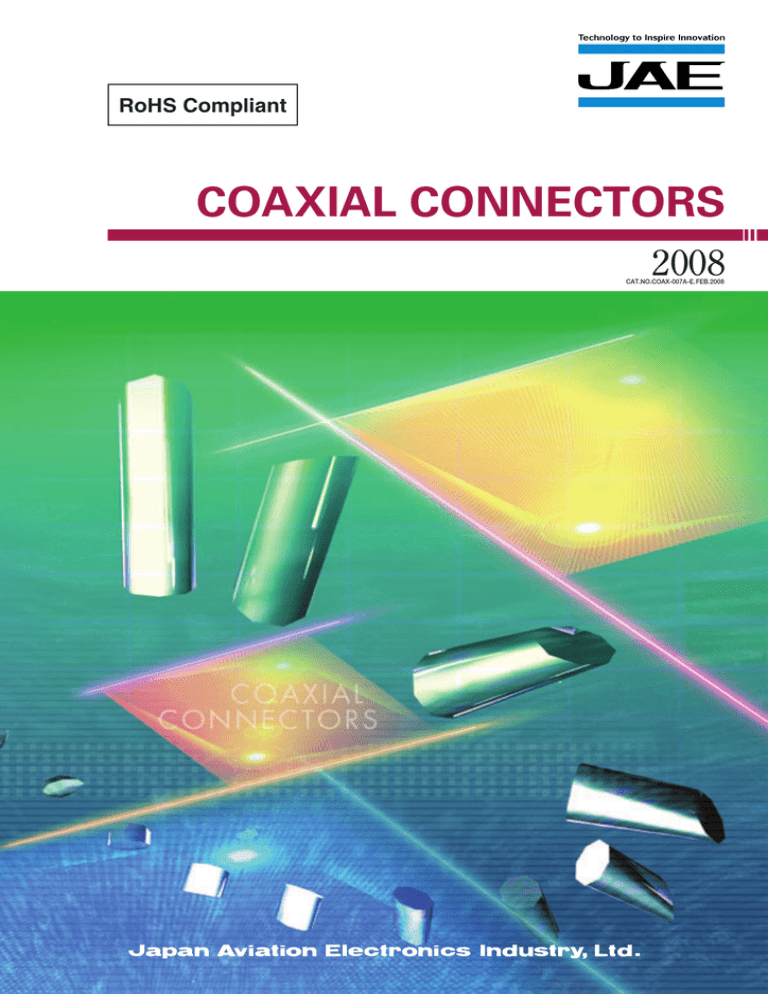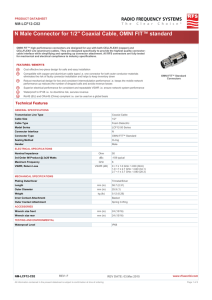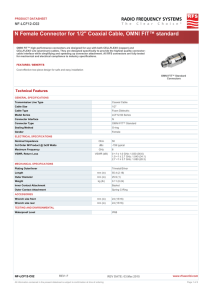20-Appendices
advertisement

RoHS Compliant COAXIAL CONNECTORS 2008 CAT.NO.COAX-007A-E.FEB.2008 COAXIAL CONNECTORS Appendices 1. Unit conversion(122 to 123 Page) ①VSWR conversion ②dBm-W conversion 2. Glossary(124 to 126 Page) 3. Frequency designations(127 Page) 4. Calculation of the VSWR of connectors in cascade connection(128 to 130 Page) 121 COAXIAL CONNECTORS Appendices ■VSWR Conversion ●VSWR Conversion Chart VSWR Reflection Coefficient S S−1 S+1 1+|Γ| 1−|Γ| Γ 10+ PR PR PR 10− PR 10 Return Loss 1+10 20 Reflection Power (%) Return Loss (dB) Transmission Power (%) 2 VSWR S Reflection Coefficient Γ Reflection Power − 2 −10 log 2 S−1 S+1 1− 2 S−1 S+1 2 ×100 −10 log 1− S−1 S+1 Γ×100 −10 log(Γ ) (1−Γ ) ×100 2 −10 log(1−Γ ) 2 PR 20−10 log(PR) 100−PR 20−10 log(100−PR) LR − LR 10 20 10 LR 1−10 Transmission Power 10+ 100−PT 100−PT PT 10− 100−PT 10 Transmission Loss 1+ 1−10 10 LR − 20 − 20−LR 10 100−PT LR 100−10 20−LR 10 LR − 10 −10 log 1−10 PT 20−10 log(100−PT) 20−10 log(PT) LT LT − 10 1−10 LT − 10 LT 2 S−1 ×100 S+1 Transmission Loss (dB) 100−10 20−LT 10 LT − 10 −10 log 1−10 10 20−LT 10 LT 1− 1−10 ●VSWR Nomograph VSWR 1.02 1.04 1.05 1.06 1.07 1.08 1.09 1.01 1.03 |Γ| 0.010 0.015 0.020 0.025 0.030 0.005 Reflection Power (%) 0 Return Loss (dB) 0.035 40 35 33 32 31 30 29 0.040 28 0.045 0.1 0.2 27 Transmission Power (%) 100 99.9 99.8 1.10 0.050 Transmission Loss (dB) 0 0.001 0.002 0.003 0.004 0.005 0.006 0.007 0.008 0.009 0.010 1.13 1.0 1.1 1.15 1.2 |Γ| 0 Reflection Power (%) 0 0.05 0.10 1 Return Loss (dB) 30 25 23 21 20 19 Transmission Power (%) 100 0 24 22 99 0.05 1.3 2 17 98 0.15 0.10 16 1.4 0.055 0.3 25 99.7 0.065 1.15 0.070 3 15 97 0.015 0.060 1.14 0.4 24 99.6 0.5 23 99.5 1.5 0.20 4 14 96 5 13 95 0.20 0.020 1.16 Transmission Loss (dB) 18 26 1.11 1.12 VSWR 1.6 0.075 0.025 0.6 1.17 99.4 6 0.25 22 0.080 1.18 0.7 99.3 0.030 94 12 0.30 1.7 7 93 0.085 1.19 1.20 1.21 1.22 122 0.090 0.8 0.095 0.9 0.100 1.0 21 99.2 99.1 0.035 8 1.8 0.30 0.040 11 9 92 91 1.9 20 99.0 10 10 90 0.40 COAXIAL CONNECTORS Appendices ■dBm-W Conversion ●dBm-W Conversion A [dBm] = 10 log10(B [mW] ) dBm mW dBm mW dBm mW dBm mW dBm W dBm W dBm W -10.0 0.100 0.0 1.00 10.0 10.0 20.0 100 30.0 1.00 40.0 10.0 50.0 100 -9.0 0.126 1.0 1.26 11.0 12.6 21.0 126 31.0 1.26 41.0 12.6 51.0 126 -8.0 0.158 2.0 1.58 12.0 15.8 22.0 158 32.0 1.58 42.0 15.8 52.0 158 -7.0 0.200 3.0 2.00 13.0 20.0 23.0 200 33.0 2.00 43.0 20.0 53.0 200 -6.0 0.251 4.0 2.51 14.0 25.1 24.0 251 34.0 2.51 44.0 25.1 54.0 251 -5.0 0.316 5.0 3.16 15.0 31.6 25.0 316 35.0 3.16 45.0 31.6 55.0 316 -4.0 0.398 6.0 3.98 16.0 39.8 26.0 398 36.0 3.98 46.0 39.8 56.0 398 -3.0 0.501 7.0 5.01 17.0 50.1 27.0 501 37.0 5.01 47.0 51.1 57.0 501 -2.0 0.631 8.0 6.31 18.0 63.1 28.0 631 38.0 6.31 48.0 63.1 58.0 631 -1.0 0.794 9.0 7.94 19.0 79.4 29.0 794 39.0 7.94 49.0 79.4 59.0 794 123 COAXIAL CONNECTORS Appendices ■Glossary 【dB (decibel) 】 The transmission performance of a connector (insertion loss, return loss, isolation), for example, is expressed in decibels, in terms of a logarithm of the ratio between magnitudes of voltage, current and power. Letting two different powers be P1 and P2 : A P1 P1 A[dB]=10 log =10 10 P2 P2 ( ) With the voltage(with the current, I1 and I2 instead of V1 and V2): B V1 V1 B[dB]=20 log =10 20 V2 V2 ( ) 【Characteristic Impedance】 Ratio of voltage to the flow of current allowed in an alternating current transmission line. Impedance expressed in ohms is analogous to R in the equation of V=IR for a direct current circuit.With high frequencies, 50 ohms and 75 ohms are typical characteristic impedance values. A good transmission characteristic is achieved by adjusting the input/output impedances of the device to 50 or 75 ohms. Also in the circuits inside the device, it is desirable to match the characteristic impedances in the whole region. d The characteristic impedance in the coaxial line is given by 60 D Z0= ln εr d √ εr ( ) where εr = dielectric constant of the insulator d = outer diameter of the core conductor D = inner diameter of the outer conductor D Coaxial line 【Reflection Coefficient】 Ratio between the reflected voltage wave V2 and the incident voltage wave V1. V2 Γ= V1 _1. With a higher degree of impedance matching, producing The value|Γ|< less reflection, the coefficient approaches zero. If a load impedance Zr is connected to a transmission line with a characteristic impedance ZC, reflection occurs. The equation for the reflection coefficient at the connection point can be written as Zr−ZC Γ= Zr+ZC 124 I(z) V(z) Zc Zr z Transmission line with end ZR COAXIAL CONNECTORS Appendices ■Glossary 【Return Loss】 Logarithmic expression of the ratio between reflecting power P2 and incident power P1 to the circuit/connector. P2 RL=−10 log [dB] P1 ( ) This can be rewritten in terms of the reflection coefficientΓ. RL=−10 log|Γ|2 [dB] 【V.S.W.R.(voltage standing wave ratio) 】 A standing wave may be formed by interference between a wave transmitted into a transmission line and a reflected wave. V.S.W.R. is the ratio of the absolute value of maximum voltage and that of minimum voltage in the standing wave pattern. With a higher degree of impedance matching, the value of V.S.W.R. approaches 1. 1+|Γ| VSWR= 1−|Γ| Either return loss or V.S.W.R. is selected as a product specification. 【Insertion Loss】 Logarithmic expression of the ratio of output power Pout to input power Pin of the circuit/connector. It is sometimes simply referred to as “attenuation”or“loss.” IL − Pout Pout IL=−10 log [dB] =10 10 Pin Pin ( ) ( ) 【S Parameter(Scattering Parameter) 】 With high frequencies, it is difficult to directly measure the voltage and current in a transmission line. The circuit characteristic can be expressed by the power measured instead of voltage or current. The S parameter is an expression that is dependent on the amplitude and phase at each port (observation point). V.S.W.R. and insertion loss described above can be obtained from the S parameter. S21 Port 1 S11 S22 Port 2 S12 An example of S parameter with two ports 【Wave Length】 Distance the electric wave travels per cycle(1Hz). In a dielectric substance such as plastic insulator, the wavelength is reduced by its relative magnetic permeability. c λ= f√ εr where c= velocity of light f= frequency εr = relative permittivity of the insulator The higher the frequency, the shorter the wavelength. As the wavelength approaches the circuit dimension, the wavelength increases in importance as a distribution constant. 125 COAXIAL CONNECTORS Appendices ■Glossary 【Skin Effect】 Direct current is uniformly distributed in the conductor section. High-frequency currents, however, flow in a narrow skin of the conductor - hence the name “skin effect.” The distance below the conductor surface where the intensity of the magnetic field falls to 1 or about 37% of its value at the conductor surface, is defined as skin depth, and is given by e ρ δ= πfμ0μs where ρ = resistivity of the conductor where μ0 = magnetic permeability of vacuum Conductor surface 1 0.37 f = frequency μs = relative magnetic permeability of the conductor 0 δ Depth Skin depth Since signals exceeding the GHz band flows in a very narrow skin of several micrometers, the conductor loss increases. 【TEM Mode(Transverse Electromagnetic Mode) 】 Dominant mode of electromagnetic wave transmitted in a coaxial line. Electric field in a section in a coaxial line is distributed radially from the core conductor to the outer conductor, whereas magnetic field forms concentric circles. The direction of the electric and magnetic fields is orthogonal, i.e., transverse, to the direction the wave is moving. Hence the abbreviated name, TEM. Electric field Magnetic field Direction of electromagnetic field in a coaxial line 【Cutoff Frequency】 In the electromagnetic field distribution in a coaxial line, a higher mode may occur depending upon the relationship between wavelength and line diameter, resulting in poorer propagation characteristics. The frequency at which the higher mode theoretically occurs is called the cutoff frequency, which is given by 2c fC= π (d+D)√ εr where c = velocity of light D = inner diameter of the outer conductor d = outer diameter of the core conductor εr = relative permittivity of the insulator The frequency in the coaxial line should be lower than the cutoff frequency. 【dBm】 A measure of absolute power value in decibels. Zero dBm equals to one milliwatt. 【Hz】 Number of signal cycles repeating per second. 【bps(bits per second) 】 Number of bits transmitted per second. 126 COAXIAL CONNECTORS Appendices ■Frequency designations Frequency designations Wave Length 30kHz 10km 300kHz 1km LF (Low frequency) MF (Medium frequency) 3MHz 100m 30MHz 10m 300MHz 1m HF (High frequency) VHF (Very high frequency) UHF (Ultra high frequency) 3GHz 10cm 30GHz 1cm 300GHz 1mm SHF (Super high frequency) EHF (Extremely high frequency) 127 COAXIAL CONNECTORS Appendices ■Calculation of the VSWR of connection in cascade connection You cannot obtain the VSWR of the circuits of connectors, cables or components in cascade connection (mating), even when the VSWR of each circuit is known, unless the S-parameter of each circuit is obtainable. The VSWR shall be calculated at each frequency. ■Calculation of VSWR You can calculate VSWR by using Snn of S-parameters (a+jb)or(r∠θ) a=r cosθ From r∠θ=r (cosθ+j sinθ) b=r sinθ { |Γ|=|Snn|= a2+b2、VSWR= 1+|Γ| 1−|Γ| ■S-parameters of connectors in cascade connection ( S 1) 11 ( S 1) 12 ( S 2) 11 ( S 2) 12 ( S 1) 21 ( S 1) 22 ( S 2) 21 ( S 2) 22 Connector 1 Connector 2 … ( S n) 11 ( S n) 12 S11 S12 ( S n) 21 ( S n) 22 S21 S22 Connector n Connector 1 +Connector 2 Transform the S-parameter of each connector into a T-parameter. T11 T12 1 −S11S22+S12S21 S11 = T21 T22 −S22 1 S21 [ ] [ ] Calculate the product of the matrices of T-parameters. T(All) 11 T(All) 12 T(1) 11 T(1) 12 T(2) 11 T(2) 12 T(n) 11 T(n) 12 = … T(All) 21 T(All) 22 T(1) 21 T(1) 22 T(2) 21 T(2) 22 T(n) 21 T(n) 22 [ ][ ][ ][ ] Inversely transform T-parameters into S-parameters. S11 S12 1 T12 T11T22−T12T21 = S21 S22 1 −T21 T22 [ ] [ ] The S-parameter thus obtained gives the S-parameter of the coaxial connectors in cascade connection. By this method, you can calculate the S-parameter of the entire circuit(including VSWR)based on the S-parameter of each connector in cascade connection. 128 COAXIAL CONNECTORS Appendices ■Calculation of the VSWR of connection in cascade connection ■An example(connectors 1 and 2 in cascade connection) CH1 S11 SWR 100 m / REF 1 S1 1.0803 CH1 S11 3 000,000 000 MHz SWR 100 m / REF 1 S1 1.0383 3 000,000 000 MHz ※ ※ CH1 Markers CH1 Markers 1 : 1.0362 1.00000 GHz 3 GHz Cor 1 : 1.0175 1.00000 GHz 3 GHz Cor 2 : 1.0493 1.50000 GHz 2 : 1.0258 1.50000 GHz 3 : 1.0621 2.00000 GHz 3 : 1.0323 2.00000 GHz 4 : 1.0360 2.50000 GHz 4 : 1.0731 2.50000 GHz ↑ ↑ 1.062(@2GHz) 1.032(@2GHz) 5 5 1 4 3 2 START 1 000.000 000 MHz 2 1 STOP 3 000.000 000 MHz Connector 1・VSWR(measured) 4 Connector 2・VSWR(measured) Let's calculate VSWR at 2GHz here as an example. The S-parameter of each connector at 2GHz is measured as: S(1) 11 S(1) 12 0.029988−0.002592j 0.408634−0.90502j = S(1) 21 S(1) 22 0.409045−0.90593j 0.023405+0.01555j [ [ 3 ][ ][ ] S 2) ( 11 S 2) ( 12 −0.007512−0.01413j 0.642835−0.76339j = S(2) 21 S(2) 22 0.642835−0.76339j −0.01136−0.007661j ] The above S-parameters can be transformed into the following T-parameters T (1) 11 T (1) 12 0.968064−68.226j 0.07518−0.0006793j = T (1) 21 T (1) 22 0.511292−0.008163j 0.0002302+0.01522j [ [ ][ ][ T (2) 11 T (2) 12 7.8211+295.214j = −2.9247+0.05822j T (2) 21 T (2) 22 2.36379−0.04696j 0.0004006+0.02003j ] ] (1)VSWRF viewed from the connector 1 when connectors 1 and 2 are connected in this order(connector 1 + connector 2) VSWRF→ ① ② ① VSWRF→ ② ( S 1) 11 ( S 1) 12 ( S 2) 11 ( S 2) 12 S(All) F 11 S(All) F 12 ( S 1) 21 ( S 1) 22 ( S 2) 21 ( S 2) 22 S(All) F 21 S(All) F 22 Connector 1 Connector 2 Connector 1+Connector 2 Transform S-parameters into T-parameters and calculate the product of the matrices of T-parameters. T(All) F 11 T(All) F 12 T(1) 11 T (1) 12 T (2) 11 T (2) 12 −0.42919−0.8943j −0.02174+0.01689j = = T(All) F 21 T(All) F 22 T(1) 21 T (1) 22 T (2) 21 T (2) 22 −0.03027−0.01444j −0.43595+0.90886j [ ][ ][ ][ Inversely transform T-parameters thus obtained into S-parameters. S(All) F 11 S(All) F 12 0.02444+0.01219j −0.42862−0.89358j = S(All) F 21 S(All) F 22 −0.42905−0.89448j −0.00007447−0.03327j [ ][ ] ] 129 COAXIAL CONNECTORS Appendices ■Calculation of the VSWR of connection in cascade connection When the connector 1 and connector 2 are connected in this order, the VSWR of this combination viewed from the connector 1 is calculated as 1.056(at 2GHz)from S(All) F 11, which is measured as 1.059 1.2 1.18 1.16 1.14 《Reference》 VSWR at 2GHz(measured) Connector 1(unit) :1.062 Connector 2(unit) :1.032 1.12 1.1 1.08 Measured(broken line) 1.06 1.04 Calculated (solid line) 1.02 1 1 1.5 2 Frequency 2.5 3 [GHz] VSWR of the combined connectors viewed from the connector 1 (2)VSWRR viewed from the connector 2 when connectors 2 and 1 are connected in this order(connector 2 + connector 1) ※Pay attention to the directions of connectors ① and ②. VSWRR→ ① ② ① VSWRR→ ② ( S 2) 11 ( S 2) 12 ( S 1) 11 ( S 1) 12 S(All) R 11 S(All) R 12 ( S 2) 21 ( S 2) 22 ( S 1) 21 ( S 1) 22 S(All) R 21 S(All) R 22 Connector 2 Connector 1 Connector 2+Connector 1 Similarly, calculate the product of the matrices of the transformed T-parameters. T(All) R 11 T(All) R 12 T (2) 11 T (2) 12 T(1) 11 T(1) 12 −0.42923−0.89477j 0.0458+0.005022j = = T(All) R 21 T(All) R 22 T (2) 21 T (2) 22 T(1) 21 T(1) 22 0.03729−0.01025j −0.4359+0.90933j [ ][ ][ ][ Inversely transform T-parameters thus obtained into S-parameters S(All) R 11 S(All) R 12 −0.01514−0.04311j −0.42823−0.89332j = S(All) R 21 S(All) R 22 −0.42866−0.89422j 0.02514+0.02896j [ ][ When the connector 2 and connector 1 are connected in this order, the VSWR of this combination viewed from the connector 2 is calculated as 1.096(at 2GHz)from S(All) R 11, which is measured as 1.091. ] ] 1.2 1.18 1.16 1.14 《Reference》 VSWR at 2GHz(measured) Connector 1(unit) :1.062 Connector 2(unit) :1.032 1.12 Calculated(solid line) 1.1 1.08 1.06 Measured(broken line) 1.04 1.02 1 1 1.5 2 Frequency 2.5 VSWR of the combined connectors viewed from the connector 2 130 3 [GHz] COAXIAL CONNECTORS 1-19, Aobadai 3-chome, Meguro-ku, Tokyo 153-8539, Japan Telephone: (81) 3-3780-2768 Facsimile: (81)3-3780-2883 http://www.jae.com http://www.jae-connector.com JAE Electronics, Inc. 142 Technology Drive, Suite 100 Irvine, California 92618-2430, U.S.A. Telephone: (1) 949-753-2600 Facsimile: (1)949-753-2699 (800)JAE-PART(523-7278) Toll free in U.S.A. except in California and Alaska JAE Europe, Ltd. Coliseum Business Center, Riverside Way, Camberley, Surrey GU15 3YL, U.K. Telephone: (44) 1276-404000 Facsimile: (44) 1276-404010 JAE Taiwan, Ltd. <Taipei Branch Office> 4F-1, No.88, Sec.2, Chung Hsiao E.Rd., Taipei, Taiwan, R.O.C. Telephone: (886) 2-2396-7676 Facsimile: (886) 2-2392-5929 JAE Hong Kong, Ltd. Suites 1407-11,14/F., Tower2, The Gateway, 25 Canton Road, Tsimshatsui, Kowloon, Hong Kong Telephone: (852) 2723-7782 Facsimile: (852) 2723-9028 JAE Shanghai Co., Ltd. RM1407, Shanghai Mart 2299 Yanan Road(West)Shanghai, 200336 P.R.C. Telephone: (86) 21-6236-0322 Facsimile: (86)21-6236-1292 JAE Singapore Pte Ltd. 33 Tannery Lane, #02-01 Hoesteel Industrial Building, Singapore 347789 Telephone: (65) 6748-1332 Facsimile: (65)6748-2920 JAE Korea, Inc. 1602, City Air Tower, 159-9, Samsung-dong, Gangnam-gu, Seoul, 135-973 Korea Telephone: (82) 2-551-8959 Facsimile: (82)2-551-8958 No part of this catalogue may be reproduced or distributed in any means, or stored in a data based or retrieval system, without the prior written permission of Japan Aviation Electronics Industry,Ltd.



